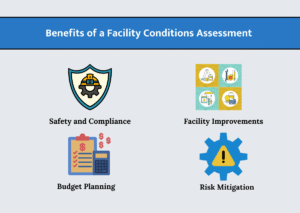
Needs Assessment vs. Facility Conditions Assessment: Optimizing Criminal Justice Facilities for Success
This is the third post in a three-part series dedicated to the topics of Needs Assessments and Facility Conditions Assessments. Check out the first two posts, Demystifying Needs Assessments: 7 Questions to Guide Justice Leaders in Defining and Implementing Effective Assessments and Enhancing Criminal Justice Facilities: The Power of Facility Conditions Assessments.
Needs Assessment and a Facility Conditions Assessment are two distinct tools that serve different purposes for criminal justice facility owners. While both assessments contribute to the overall evaluation and improvement of a facility, they focus on different aspects and provide unique insights.
Let’s explore the differences between the two and their respective purposes.
Needs Assessment
A Needs Assessment is a systematic process that aims to identify the specific requirements, challenges, and service gaps within a given context. In the context of criminal justice facilities, a Needs Assessment focuses on understanding the needs of the inhabitants of facilities, such as staff and the incarcerated population, including their physical and mental health, educational and vocational programs, substance abuse treatment, reintegration services, and more. A Needs Assessment provides facility owners with insights into the specific needs and challenges faced by incarcerated individuals, allowing them to prioritize and allocate resources effectively. This assessment helps guide decision-making, strategic planning, program development, an d resource allocation to create safe environments that foster growth, reduce recidivism, and promote successful rehabilitation.
d resource allocation to create safe environments that foster growth, reduce recidivism, and promote successful rehabilitation.
Benefits of a Needs Assessment:
- Informed decision-making: Facility owners gain valuable insights into the areas that require attention and improvement, enabling them to make informed decisions.
- Resource allocation: By understanding the specific needs of the incarcerated population, owners can allocate resources effectively to provide the right programs, services, and interventions.
- Strategic planning: A Needs Assessment assists in developing evidence-based policies and initiatives tailored to the unique challenges faced by the incarcerated individuals.
- Monitoring and evaluation: Regular reassessment of needs allows owners to evaluate the effectiveness of existing programs and make necessary adjustments for optimal outcomes.
Example scenario: If a correctional facility wants to improve its educational programs and determine the specific needs of the inmate population in terms of education, a Needs Assessment would be the appropriate tool to use. The assessment would gather data on the current state of educational programs, identify gaps, and provide insights into the specific educational needs of the incarcerated individuals.
Facility Conditions Assessment
A Facility Conditions Assessment, on the other hand, focuses on evaluating the physical infrastructure, safety protocols, compliance with regulations, and overall conditions of the facility itself. This assessment examines the structural integrity, maintenance requirements, security systems, cleanliness, and adherence to safety standards. The purpose of a Facility Conditions Assessment is to identify any deficiencies or areas that require improvement to ensure a safe and conducive environment for both staff and inmates.
 Benefits of a Facility Conditions Assessment:
Benefits of a Facility Conditions Assessment:
- Safety and compliance: Identifies potential safety hazards, compliance issues, and areas where the facility may not meet industry standards or regulations.
- Facility improvements: Provides facility owners with a clear understanding of maintenance needs, infrastructure upgrades, and necessary repairs.
- Budget planning: Helps facility owners allocate resources for facility improvements based on identified deficiencies.
- Risk mitigation: By identifying potential security vulnerabilities, a Facility Conditions Assessment allows owners to address them proactively and mitigate risks.
Example scenario: If a correctional facility is experiencing infrastructure problems such as plumbing issues, deteriorating buildings, or outdated security systems, a Facility Conditions Assessment would be appropriate. The assessment would evaluate the current state of the facility, identify areas that require repairs or upgrades, and provide recommendations for improvement.
Comparing Needs Assessments and Facility Conditions Assessments
- Purpose: A Needs Assessment focuses on understanding the specific needs of the incarcerated population, while a Facility Conditions Assessment evaluates the physical infrastructure and conditions of the facility itself.
- Benefits: A Needs Assessment informs decision-making, resource allocation, and strategic planning, while a Facility Conditions Assessment ensures safety, compliance, facility improvements, and risk mitigation.
- Application: A Needs Assessment is used to address the needs and challenges faced by incarcerated individuals, while a Facility Conditions Assessment is used to evaluate and improve the physical conditions and infrastructure of the facility.
In summary, a Needs Assessment and a Facility Conditions Assessment are distinct tools that serve different purposes for criminal justice facility owners. Facility owners should choose the service based on their specific goals and the areas they want to evaluate and improve within their facility. In some scenarios it may be beneficial to combine both tools for a comprehensive understanding of inmate needs as it relates to the physical environment.





